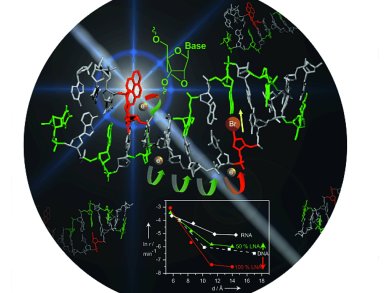In this issue’s Review, P. G. Bruce et al. discuss challenges in the design of lithium batteries and electrical double-layer capacitors. How can new materials and electrochemical reactions be developed and the underlying processes be better understood? S. E. Denmark and T. W. Wilson point out the versatility of silyl ketene imines as nucleophiles for catalytic asymmetric synthesis in a Minireview. The Highlights deal with hydrogen bonds to the 5′-deoxyadenosyl radical (T. Golding et al.) and stable boron-containing π-conjugated materials (W. E. Piers et al.). In an Author Profile, A. Osuka answers questions from D. Seidel.
In the Communications section, H.-A. Wagenknecht et al. report on photoinduced reductive electron transfer in LNA:DNA hybrids and its significance for molecular electronics. In the gas-phase IR spectra of mass-selected ion pairs, D. Schröder et al. found evidence for a hindered intramolecular redistribution of vibrational energy, which leads to a non-ergodic behavior on a timescale sufficient for the formation of new chemical bonds. D. O’Hagan et al. succeeded in the synthesis of hexafluorocyclohexane from benzene almost 200 years after the syntheses of the chlorine and bromine analogues from benzene were described by Faraday and Mitscherlich, respectively. D. Ma et al. present a potentially biomimetic total synthesis of (±)-gracilamine.


